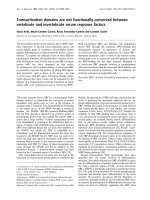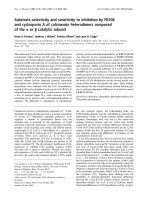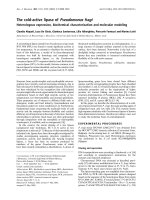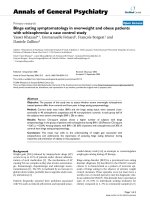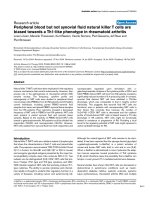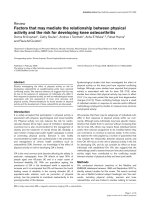Báo cáo y học: "Too cold may not be so cool: spontaneous hypothermia as a marker of poor " ppt
Bạn đang xem bản rút gọn của tài liệu. Xem và tải ngay bản đầy đủ của tài liệu tại đây (117.36 KB, 2 trang )
den Hartog and colleagues prospectively analyzed data
from 105 consecutive comatose patients resuscitated from
cardiac arrest (CA) and treated with therapeutic hypo-
thermia (TH) over a 2-year period [1]. ey observed
that the percentage of patients with unfavourable
outcome (including death, vegetative state and severe
disability) was signifi cantly higher in patients with
spontaneous hypothermia (69%) than in those with a
body temperature ≥35°C on admis sion to the ICU (50%,
P = 0.05). Using multivariable analysis, and adjusting for
age, initial arrest rhythm, and APACHE II and SOFA
scores, the association between spontaneous hypo-
thermia and outcome at 6 months was confi rmed.
In this single centre prospective cohort of more than
100 patients, spontaneous hypothermia remained
signi fi cantly associated with long-term outcome, even
when adjusted for APACHE II and SOFA scores. is
indicates that low body temperature <35°C on admission
after CA is a strong marker of neuro logical recovery.
Previous studies have shown that spontaneous hypo-
thermia is associated with increased mortality after severe
trauma and haemorrhage [2]. TH has improved prognosis
of hypoxic-ischemic encephalopathy [3], and might have
an impact on our ability to predict fi nal patient prognosis
[4]. den Hartog and colleagues identify spontaneous
hypothermia as a new prognostic marker of CA.
However, in accordance with Utstein’s style registry [5],
arrest condi tions (that is, witnessed versus un-witnessed
arrest), initial arrest rhythm (that is, ventricular fi brilla-
tion versus non-ventricular fi brillation) and duration of
circulatory arrest (that is, time from collapse to return of
spontaneous circulation) are other well-known predictors
of prognosis [6]. ese para meters, and particularly time
to return of spontaneous circulation, were not entered in
the logistic regression; thus, it remains to be further
established whether spon taneous hypothermia is an
independent predictor of outcome. Furthermore, body
temperature may be diffi cult to measure precisely, and
reasons for spon tan eous hypothermia can be multiple:
for example, CA occurring in cold environments may
have better neurological recovery despite low admission
body temperature [7]. erefore, although admission
body temperature is an important parameter and a
marker of injury severity, it should not be considered
alone to guide therapy.
Notwithstanding these limitations, which are well
recognized by the authors, the fi ndings by den Hartog
and colleagues are important and indeed in line with
previous trauma [2] and more recent post-CA [8] studies
showing that spontaneous hypothermia is associated
with higher mortality. Pathophysiological mechanisms
may involve extended damage to specifi c brain areas
leading to impaired thermoregulation [9], thereby estab-
lish ing a plausible relationship between post-anoxic injury,
Abstract
In a recent issue of Critical Care, den Hartog and
colleagues show an association between spontaneous
hypothermia, de ned by an admission body
temperature <35°C, and poor outcome in patients
with coma after cardiac arrest (CA) treated with
therapeutic hypothermia (TH). Given that TH alters
neurological prognostication, studies aiming to
identify early markers of injury severity and outcome
are welcome, since they may contribute overall to
optimize the management of comatose CA patients.
This study provides an important message to clinicians
involved in post-resuscitation care and raises important
questions that need to be taken into account in future
studies.
© 2010 BioMed Central Ltd
Too cold may not be so cool: spontaneous
hypothermia as a marker of poor outcome after
cardiac arrest
Jakobea Wörner and Mauro Oddo*
See related research by den Hartog et al., />COMMENTARY
*Correspondence:
Department of Intensive Care Medicine, Lausanne University Hospital (Centre
Hospitalier Universitaire Vaudois), Rue du Bugnon 46, 1011, Lausanne, Switzerland
Wörner and Oddo Critical Care 2010, 14:1002
/>© 2010 BioMed Central Ltd
impaired hypothalamic thermoregulation with spon-
taneous hypothermia, and unfavourable outcome. Never-
theless, it should be noted that previous studies predomi-
nantly described hyperthermia, instead of spontaneous
hypothermia, as a result of hypothalamic damage [10].
is study may also help explain some recent clinical
observations. In particular, it was recently shown that
early cooling did not seem to translate into better out-
come [11]. is is in contrast with the abundant experi-
mental literature [12] and some recent clinical evidence
[13,14]. However, spontaneous hypothermia may have
been a major confounding factor of these studies. While
animal studies are conducted in stable condi tions, this
may often not be the case in humans after CA. In such
conditions, time to target temperature may not be a
reliable parameter, unless it is corrected for baseline
demographics, including admission body temperature.
In conclusion, the fi ndings by den Hartog and
colleagues identify spontaneous hypothermia as a new
prognostic marker that may have an infl uence on neuro-
logical recovery from CA. Together with other well-
known outcome predictors [15], admission body temp-
era ture should therefore be included in the early assess-
ment of comatose CA patients and will be an important
variable to be taken into account in future studies.
Abbreviations
APACHE, Acute Physiology and Chronic Health Evaluation; CA, cardiac arrest;
SOFA, Sequential Organ Failure Assessment; TH, therapeutic hypothermia.
Competing interests
The authors declare that they have no competing interests.
Published: 20 October 2010
References
1. den Hartog AW, de Pont AC, Robillard LB, Binnekade JM, Schultz MJ, Horn J:
Spontaneous hypothermia on intensive care unit admission is a predictor
of unfavorable neurological outcome in patients after resuscitation:
anobservational cohort study. Crit Care 2010, 14:R121.
2. Wang HE, Callaway CW, Peitzman AB, Tisherman SA: Admission hypothermia
and outcome after major trauma. Crit Care Med 2005, 33:1296-1301.
3. Hypothermia after Cardiac Arrest Study Group: Mild therapeutic
hypothermia to improve the neurologic outcome after cardiac arrest.
NEngl J Med 2002, 346:549-556.
4. Rossetti AO, Oddo M, Logroscino G, Kaplan PW: Prognostication after
cardiac arrest and hypothermia: a prospective study. Ann Neurol 2010,
67:301-307.
5. Langhelle A, Nolan J, Herlitz J, Castren M, Wenzel V, Soreide E, Engdahl J,
Steen PA; 2003 Utstein Consensus Symposium: Recommended guidelines
for reviewing, reporting, and conducting research on post-resuscitation
care: the Utstein style. Resuscitation 2005, 66:271-283.
6. Oddo M, Ribordy V, Feihl F, Rossetti AO, Schaller MD, Chioléro R, Liaudet L:
Early predictors of outcome in comatose survivors of ventricular
brillation and non-ventricular brillation cardiac arrest treated with
hypothermia: a prospective study. Crit Care Med 2008, 36:2296-2301.
7. Friberg H, Rundgren M: Submersion, accidental hypothermia and cardiac
arrest, mechanical chest compressions as a bridge to nal treatment:
acase report. Scand J Trauma Resusc Emerg Med 2009, 17:7.
8. Lyon RM, Richardson SE, Hay AW, Andrews PJ, Robertson CE, Clegg GR:
Esophageal temperature after out-of-hospital cardiac arrest: an
observational study. Resuscitation 2010, 81:867-871.
9. Morrison SF, Nakamura K, Madden CJ: Central control of thermogenesis in
mammals. Exp Physiol 2008, 93:773-797.
10. He Z, Yamawaki T, Yang S, Day AL, Simpkins JW, Naritomi H: Experimental
model of small deep infarcts involving the hypothalamus in rats: changes
in body temperature and postural re ex. Stroke 1999, 30:2743-2751;
discussion 2751.
11. Nielsen N, Hovdenes J, Nilsson F, Rubertsson S, Stammet P, Sunde K, Valsson F,
Wanscher M, Friberg H; Hypothermia Network: Outcome, timing and
adverse events in therapeutic hypothermia after out-of-hospital cardiac
arrest. Acta Anaesthesiol Scand 2009, 53:926-934.
12. Krieger DW, Yenari MA: Therapeutic hypothermia for acute ischemic stroke:
what do laboratory studies teach us? Stroke 2004, 35:1482-1489.
13. Kim F, Olsufka M, Longstreth WT Jr, Maynard C, Carlbom D, Deem S,
Kudenchuk P, Copass MK, Cobb LA: Pilot randomized clinical trial of
prehospital induction of mild hypothermia in out-of-hospital cardiac
arrest patients with a rapid infusion of 4 degrees C normal saline.
Circulation 2007, 115:3064-3070.
14. Wol B, Machill K, Schumacher D, Schulzki I, Werner D:
Early achievement of
mild therapeutic hypothermia and the neurologic outcome after cardiac
arrest. Int J Cardiol 2009, 133:223-228.
15. ECC Committee, Subcommittees and Task Forces of the American Heart
Association: 2005 American Heart Association Guidelines for
Cardiopulmonary Resuscitation and Emergency Cardiovascular Care.
Circulation 2005, 112(24 Suppl):IV1-203.
doi:10.1186/cc9270
Cite this article as: Wörner J, Oddo M: Too cold may not be so cool:
spontaneous hypothermia as a marker of poor outcome after cardiac
arrest. Critical Care 2010, 14:1002.
Wörner and Oddo Critical Care 2010, 14:1002
/>Page 2 of 2

